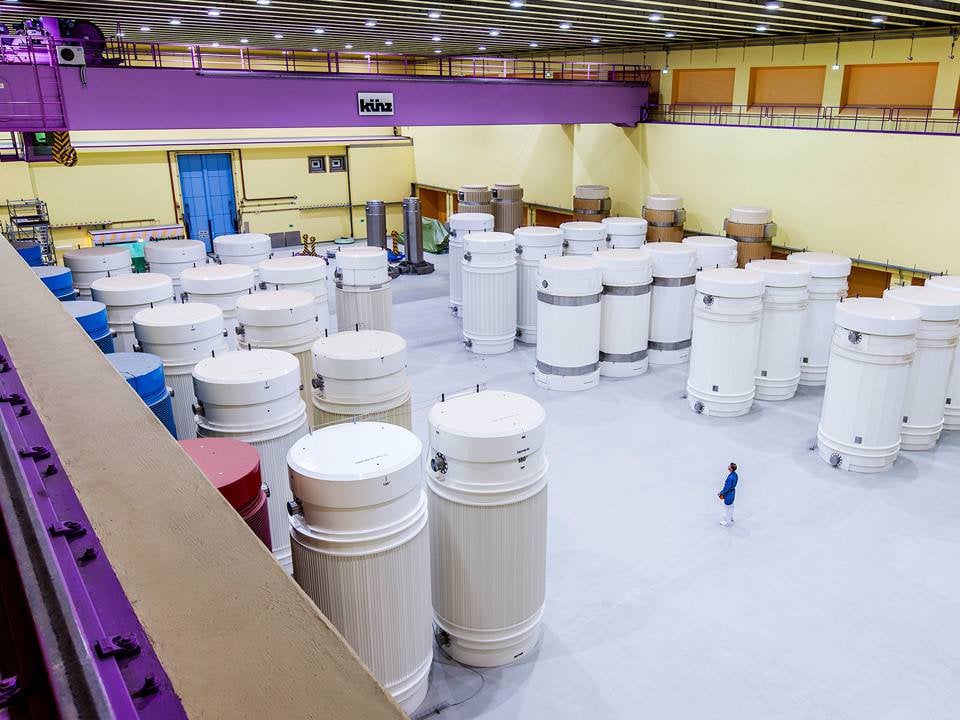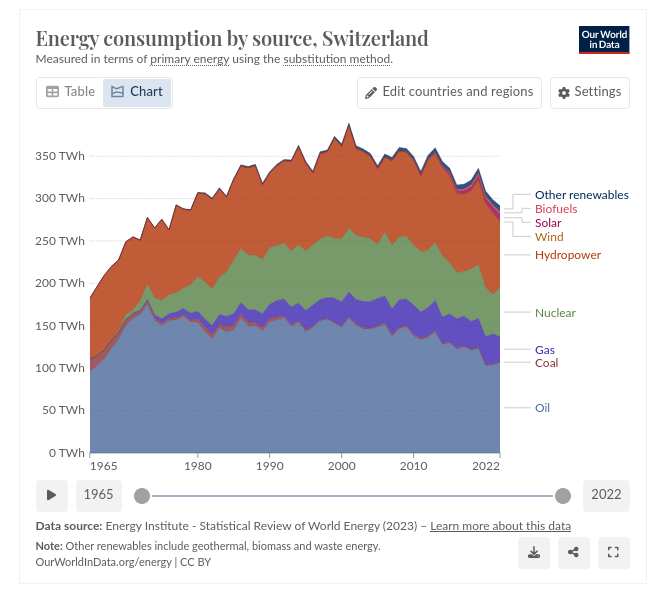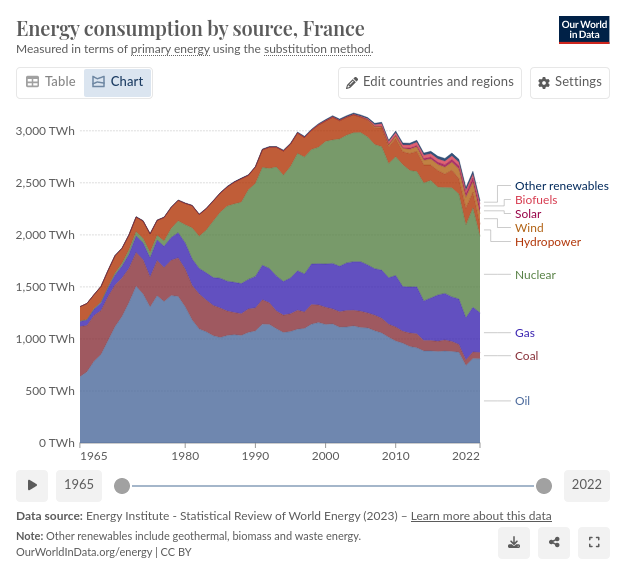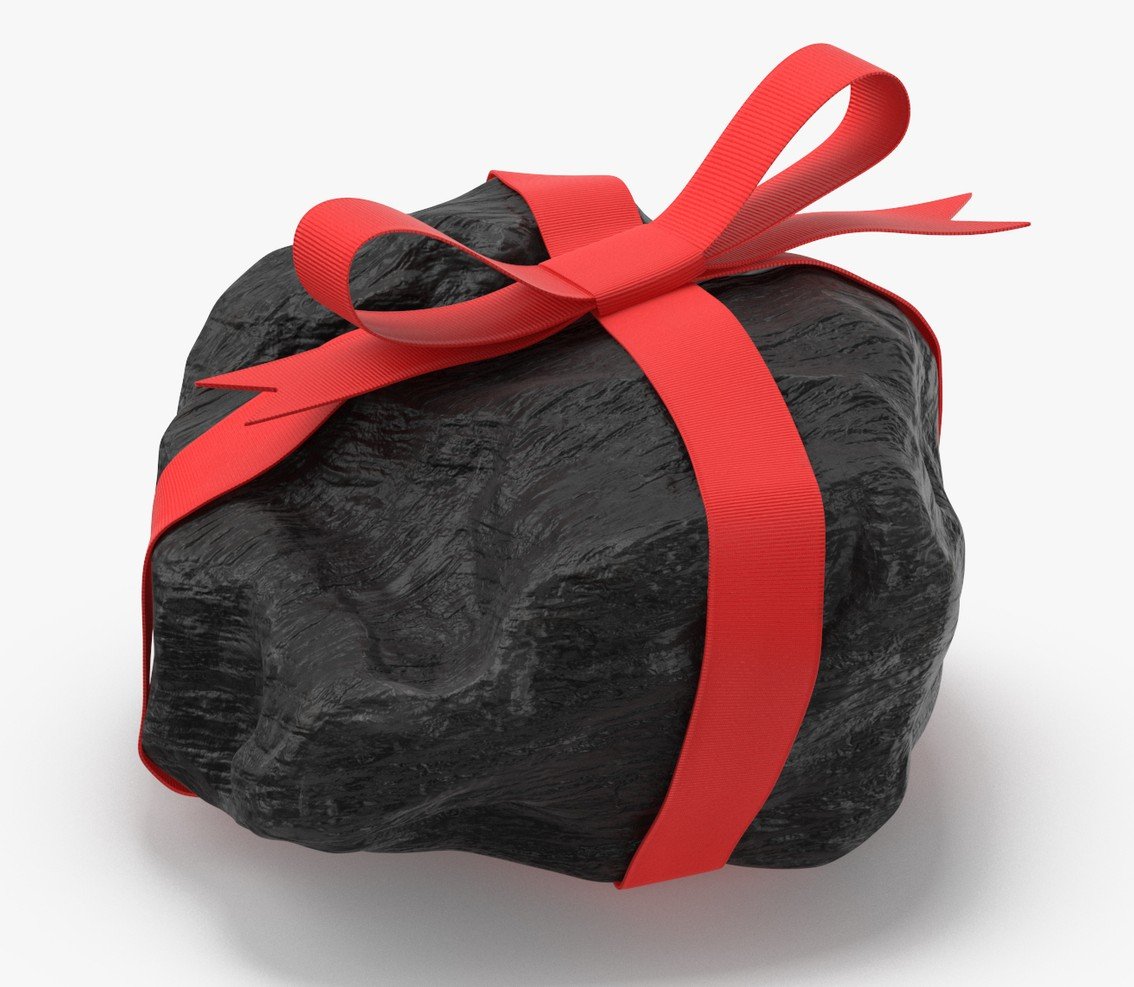Wow, imagine where we’d be if Oil and Gas hadn’t convinced almost everyone that solar was never going to work well.
Imagine where we’d be if people didn’t automatically think nuclear power=Homer Simpson
The great thing about nuclear power is that the real cost only comes after the power has been generated. How do you store the spent fuel cells and what do you do with the reactor when it can’t be used anymore. Just before that happens you spin the plant into its own company. When that company goes bankrupt the state needs to cover the cost, as it isn’t an option to just leave it out in the open.
Privatise profit communalism cost.
 Here’s all of Switzerland’s high level nuclear waste for the last 45 years. It solid pellets. You could fit the entire world’s waste on a football field.
Here’s all of Switzerland’s high level nuclear waste for the last 45 years. It solid pellets. You could fit the entire world’s waste on a football field.It’s not the greatest challenge mankind have faced.
In Germany, we’ve got a location with 47,000 cubic meters: https://www.bge.de/en/asse/
That requires some pretty tall stacking on that football field. Or I guess, you’re saying if you’d unpack it all and compress it?Also, we really should be getting the nuclear waste out of said location, since there’s a known risk of contamination. But even that challenge is too great for us, apparently.
Mainly, because we don’t have any locations that are considered safe for permanent storage. It’s cool that Switzerland has figured it out. And that some hypothetical football field exists. But it doesn’t exist in Germany, and I’m pretty sure, Switzerland doesn’t want our nuclear waste either.In Germany, we’ve got a location with 47,000 cubic meters: https://www.bge.de/en/asse/
Read your link: 47 000m³ of low and intermediate radioactive waste.
Low radioactive waste is objects (paper, clothing, etc…) which contain a small amount of short-lived radioactivity, and it mostly comes from the medical fields, not nuclear plants, so even if you phase out of nuclear, you’ll have to deal with it anyway.
This waste makes up for the vast majority (94% in UK for example) of the nuclear waste produced, and you can just leave it that way a few years, then dispose of it as any other waste.
Intermediate radioactivity waste is irradiated components of nuclear power plants. They are in solid form and do not require any special arrangement to store them as they do not heat up. This includes shorts and long-lived waste and represents only a small part of the volume of radioactive waste produced (4% in UK).
So you’re mostly dealing with your medical nuclear waste right here, and you can thank your anti-nuclear folks for blocking most of your infrastructure construction projects to store this kind of waste.
That shit still needs to be stored. I do not know, why you’re berating me about it.
I did not berated you, I corrected you. If being corrected feel like being berated to you, maybe fact check yourself before commenting
I’m speaking strictly of the mass. Most the volume on those containers are likely structure to make sure there is no accidental leak, similar to Switzerland.
I also misremembered, it was all of US’ waste that could fit on a single football.
Unfortunately, there’s not much structure to these, no. It’s nuclear waste from the 60s and early 70s, when there were practically no safety laws in place yet. They just got dumped down there in steel barrels. In a salt mine, which now has water entering it. I’m hoping, the barrels got at least filled up with concrete, but I have no idea.
we don’t have any locations that are considered safe for permanent storage
I’m gonna hazard a guess that the “consideration” was not from actual scientists but rather activist homeowner groups in every potential site.
NIMBYism and nuclear, name a more iconic duo
I mean, can you blame them? Why would anyone want toxic waste in their backyard? Not to mention that the search is mainly conducted by companies, which have a vested interest in not making all the issues transparent.
Having said that, I am not aware of the ‘scientists’ coming up with good suggestions either. Gorleben got hemmed and hawed around for the longest time, but its selection process was non-scientific from the start.
It’s genuinely not easy to find a location where anyone would be willing to claim that it will remain unaffected by geodynamic processes for millions of years. And we don’t have a big desert or some other unpopulated area where you could chuck it without political opposition, when it’s not 110% safe to do so.
Why would anyone want toxic waste in their backyard?
It’s not toxic, nor is it in their backyard.
Not to mention that the search is mainly conducted by companies, which have a vested interest in not making all the issues transparent.
What issues?
It’s genuinely not easy to find a location where anyone would be willing to claim that it will remain unaffected by geodynamic processes for millions of years.
I mean, can you blame them?
Yes. I do it a lot.
Also want to point out, most of that is container, not spent fuel. The safety standards are so ridiculously high that they basically guarantee zero risk.
More people (per plant) are exposed to elevated levels of radiation due to coal power, and that’s not even including the health risk of all the other shit they release
According to Our World In Data (which claims to use the Energy Institute’s Statistical Review of World Energy from 2023 as a data source), that waste is from producing around 70 TWh each year:

That only covers around a third of Switzerland’s energy consumption over those years. Furthermore, Switzerland is a small mountainous country with decent access to hydropower (making up around a third of its needs over the same years). They are not necessarily representative of the waste that would accumulate from a more agressive switch from fossil fuels to nuclear across the world (which is what we’re talking about, if I’m not mistaken).
France is about 10 times larger in surface area and according to the same source, consumed/produced over 1,000 TWh of nuclear energy each year:

And officially has still has no place to put the high-energy waste (source - in french), leaving it up to the plant’s owners to deal with it. There is an official project to come up with a “deep” geological storage facility, but no political will seems musterable to make that plan materialize beyond endless promises.
I should mention that I’m not super anti-nuclear, and I would certainly rather we focus on eliminating coal and oil power plants (and ideally natural gas ones as well) before we start dismantling existing nuclear reactors that are still in functioning order.
That being said, there are other problems with nuclear moving forwards besides waste management. The main one that worries me is the use of water for the cooling circuits, pumped from rivers or the sea. Not only do open cooling circuits have adverse affects on their surrounding ecosystems, as the planet gets warmer and the temperature swings during the hotter seasons become more pronounced, the power plants will become less efficient. The water going in will be at a higher temperature than it is today, and thus will absorb less energy from the nuclear reaction itself.
Overall, I don’t trust our current collective responsibility as a species to manage our current forms of nuclear production. Russia sent its own troops into the Chernobyl Exclusion Zone to dig trenches in contaminated soil last year, and they allegedly recognized last week that the Zaporizhzhia power plant is now “unsafe to restart” because of the military activity in the region.
The world has not experienced generalized warfare with nuclear power plants dotting the countryside; WW2 ended around a decade before the first nuclear power plants were up and running in the USSR, the UK, and the USA.
Not to mention how few European countries have access to uranium on their own soil/territory. Of course, most of the rare earth metals used in photoelectric panels and windmills aren’t found there either, but as least with “renewables” they are used once to make the machinery, not as literal fuel that is indefinitely consumed to produce power.
I don’t know enough about thorium-based reactors nor molten salt-based reactors to go to bat for them instead, but they seem like a more promising way for nuclear to remain relevant.
I don’t think solution for storage would be a problem if politicians had more of a backbone with deciding a place for storage, and I frankly don’t see a future without fossil fuels where nuclear doesn’t play a key role. All of the US’ nuclear waste could fit on a football field 3 meters tall. We got space for it.
As for energy security. Canada is a massive producer, and NexGen Energy is sitting on a massive deposit. Most utilities store ~4 years of material on site, and the fact it’s so easily stored for many years is why Japan invested heavily in it in all those years ago. I don’t think access to uranium is much of a concern.
and I frankly don’t see a future without fossil fuels where nuclear doesn’t play a key role
I think the anti-nuclear idiots are, well, idiots, but I disagree with you here. I think the idiots have successfully blocked nuclear long enough that it’s just more economical to go full renewable + storage. Yeah, we should have had nuclear 50 years ago and would probably be looking at a much more habitable planet, I fully agree. But I think the ship has sailed.
France made a record year last year, with 320TWh of nuclear power produced for a total of 434 TWh of electricity, while being the top exporter of electricity of Europe.
I don’t know how they got to 1000TWh of nuclear a year, I suspect weed.
It’s not that difficult to store it’s just a rock. You just pop it in a sealed casket, put it underground, mark the location as do not enter and then forget about it. Hardly the greatest of economic challenges.
Anyway you’re assuming that we won’t have a way of recycling it in the future and there’s increasing evidence that we will be able to pretty soon.
That is a horribly naive underselling of what’s involved in storing nuclear waste. How do you transport it? What do you do in the event of an accident during transport? Where is it stored now? Is it somewhere we can get good transport in? How do you mark something “do not enter” for tens of thousands of years? Think of what languages existed during the Roman Empire, and then realize that we’ll have to store it for orders of magnitude longer than that.
Logistics, logistics, logistics. They are not easy for even the simplest projects.
We do have the recycling technology. It’s not a far off thing; been developed for decades. If there’s a good reason for a nuclear renaissance, it’s in using the waste we already have, and recycling it down to something that’s only dangerous for centuries, not millennia.
All of the infrastructure for transporting nuclear waste already exists for transporting the existing nuclear waste.
Realistically it’s the only viable long-term option it’s infinitely better than fossil fuels and Fusion power would be nice but doesn’t exist yet at least not outside of a lab and I don’t think even in the lab particularly efficient.
Realistically it’s the only viable long-term option
No, it isn’t. Solar+wind+storage will do fine.
Fusion power would be nice but doesn’t exist yet at least not outside of a lab and I don’t think even in the lab particularly efficient.
And the fact that you word things this way makes it pretty clear to me you have no idea what you’re talking about and haven’t actually researched anything about it.
Is it too much to ask for people to not get their political opinions from cartoons?
Instructions unclear, politics informed by WW2 doctor Seus propaganda.
Sounds like you should install double what you think you need. Reason? The panels will start losing efficiency over time and your electricity usage over time will do nothing but grow. That’s very common.
Dude.
Those panels lost only 20%, so far from half, in 32 years.
That’s impressive.
I didn’t say they lost half but they lost 20% so you need to have at least 120% today and then you need to account for the fact that you will get more electric devices in the future. How are you going to charge your electric car if you don’t have the electric to do it? So therefore you should probably double it.
This is gonna sound so dumb… But they had solar panels back then?!
Jesus Christ. Look, back in the Stone Age when I went to school the coolest calculator was the TI-36 Solar. It was already that mundane.
Naturally, I used a non-solar Casio, because I wasn’t one of the cool nerds.
damn you just reminded me my mom bought a basic calculator with tiny solar panel 25 years ago : it is still working !
And then there are the calculators with fake solar cell windows
Carter called for solar panels to be installed on the White House in 1979. Modern ones are probably way more efficient but they were definitely a thing.
Oh yeah, how about coal? Does that get any less efficient over time? Exactly. I’ve been burning the same lump of coal for easily the same amount of time and it remains 100% efficient, that’s the beauty of combustible fuel.
/s I’m assuming.
/s or bot or completely degenerate
I’m not familiar with that letter.
Assuming you’re asking in good faith, the “/s” is usually added to denote sarcasm online.
Photo?

That is a very neat bow 😄
As far as I know that’s nothing to write home about, monocrystaline solar panels get like ~30 years dropping down to 80% and then slowly begin to fail from there. I’m far from an expert, but my understanding is this is the norm and that if we found out they weren’t lasting this long then people would be getting worried about a messed up cost calculous.
That’s correct, but most of those calculations were based on theoretical figures used by artificial aging methods and computed failure rates. Now we have real world data from panels that actually aged that long.
What’s not included in the article is how much additional power might be produced by replacing them with newer systems.
Sure but you also haven’t lost any of the power that wasn’t generated by them being dead/broken
Also I don’t think we’ve really run out of suitable space to install new panels. If that ever happens it might be worthwhile to replace them, but as you said we can otherwise just run them alongside new installations until they break or maintenance costs surpass their profits
A significant portion of the cost of solar, is the installation costs. There’s not much you can do about how much work goes into installing panels, and this will get more expensive over time as wages rise. A more efficient panel means less to install, bringing down that installation cost
I don’t yet have solar panels so am not sure what they’d do, but at least half of my south facing roof is always shaded. Is the remaining half the roof sufficient space? I don’t know, but panel size is critical.
I thought that solar panels that old performed much worse or stopped working. Especially considering where the tech was in the 1990s.
There is a solar plant in switzerland that still has functioning panels from the early 80s.
They work fine, just not at full capacity. Financing and payback calculations tend to assume they’ll be replaced after 30 years, but that’s just guesses made by accountants, not reality.
Similar holds for EV or phone batteries. They usually don’t suddenly die, but lose more and more health over time. Realistically, you have to set a threshold, where you call it no longer useful.
If the life expectancy was 80%, then we’ve passed it and they are due for replacement. If it was 70% the they still have years of useful life.
It’s probably one of those two. For phones, I replace batteries when health drops to 80%, because I spend too much of my life online. Also, I’m probably giving my phone to my kid about then, so they deserve a fresh battery. I have kept phone batteries down to about 70% life, but then it usually doesn’t last the day and I’m carrying portable chargers everywhere
I haven’t had an EV long enough but I believe the typical battery warranty is defined like that: not just that it’ll work for 10 years, but that it will still be at least 70% health after ten years
Fortunately and unfortunately, there have been so many changes and breakthroughs on solar power over the last 50 years that this doesn’t really tell us much about current technology.
It’s funny how all the FUD idiots say that solar panels will wind up in the landfill and shit like that
Just read to the top comment saying it’s profitable to replace them anyway.
And then the top comment to THAT comment wondering where and how to buy the still-effective replaced ones.
Just buy more and put them next to it lmao.
The weird thing is that in this scenario these panels are still applicable for replacement probably because the the solar panels of today compared to then are about ~40% more efficient. So compared to a new replacement it’s at around 60% efficiency. A major site plans profit off of 30 years and plans to replace glass at that time, so while it may still be somewhat useful long term it’s probably more profitable to replace them.
I wonder if this type of economic calculus would mean a supply of inexpensive, second-hand panels might be available in the next few years.
They already are, at least for the smaller ones. You can go to your citie’s parks and recreation department to get some. All those solar panels that power various signs and lights have been collected and replaced for years. I picked up a few years ago in Lexington, KY, for next to nothing, and they worked just fine for the lights that I wanted to power, despite only outputting less than 50% of their original power.
Not sure where you would find the full size ones like these pictured.
… And since they’re still good they can be resold and used by others where efficiency isn’t the main concern, no need to trash them
I want to add they aren’t even that inefficient for 20 year old tech thats impressive
I’m sorry to tell you that the nineties were a little longer ago than that!
You mean I shouldn’t wear my baggy pants with a chain for my wallet anymore?
I doubt they put out much power at all compared to modern panels. Solar back then was a pipe dream, we didn’t have the battery technology to store the energy and the panels had a lower voltage and could supply less current.
I have a 100w foldable panel for camping that at >= 20% efficiency is probably double what the 90s panels could do.
In the 90s, rooftop solar was around 10-15% efficient. Now rooftop panels are closer to 20%.
Some are 25% now, and don’t even break the bank. You can get modules that store the power and feed it back into your house for use later. I kinda want to get some to offset heating and cooling costs.
https://us.ecoflow.com/products/175w-rigid-solar-panel?variant=41362064179273
That one doesn’t seem like it’s worth it at the regular price though, seeing as it’s only 175W. You can get a 400W QCell Q.Peak panel for the same price or cheaper. I guess it’s useful if your use case needs smaller panels.
A major source of calculator power!
I’m getting some new panels installed this year, and I think they’re suggesting they’ll be at 80% after 25 years.
It looks like there is disagreement between the title and content of the article. Title says 75.9, content says 79.5
Either way, does this suggest that new panels might do better than expected over a 30 year timespan?
Title says 75.9, content says 79.5
Looks like there’s a typo in the English title. The French one has 79.5%.
To give you an idea, my 12-panel PV system installed in 2011 has put out 3.5 MWh per year at its peak and now produces between 3.1 and 3.3 MWh yearly, depending on the weather.
It’s hard to attribute that just to panel degradation, though. It could be differences in weather (cloudier or snowier this year) for example.
To measure degradation, you’d need to track the peak output of each panel. Enphase microinverters let you get per-panel metrics but I’m not sure which other brands do.
I’m pulling data from my panels into Home Assistant via Enphase’s local API (directly from the device), then into VictoriaMetrics (which is similar to Prometheus but with a more efficient file format). I’ve got per-panel production data at 5 minute granularity from when I installed them until now.
Dan you sound like a rad dude ad I’d love to have a beer with you
Hah, thanks (if you’re serious)! Feel free to DM me if you’re ever in the San Francisco Bay Area.
Newer panels are generally much more efficient and produce more electricity compared to old panels.
The 80% after 25 years might be their warranty, my panels have a similar warranty on them. If they start producing less than 80% of their original output before 25 years, the manufacturer will replace them (or something like that).
Yes, I’m looking at the paperwork and I’m realizing that you’re right, 80% at 25 is the warranty guarantee, so I’m guessing they’re confident it’ll typically be much better than 80 at 25
Or that they were expecting to be out of business by then…
The warranty is provided by the manufacturer of the solar panels, not by the installer. If your installer goes out of business, you can claim the warranty via another installer.
Of course, it’s possible the manufacturer will go out of business or sell their business.
yeh, thats what I mean, who knows what the state of the market will be in 25 years, unless its an insurance backed guarantee, be very suspicious of it.
For what it’s worth, a lot of the major manufacturers (QCell, REC, Canadian Solar) have been in business since the late 90s or early 2000s. SunPower (now Maxeon) has been around since 1985.
It’s a very conservative estimate, as manufacturers really don’t want to deal with warranty claims.
One part of solar system design is often to undersize the inverter a bit, so you might not see any degradation in the first few years at all. The logic there is that the electricity lost to clipping during peak times of the year doesn’t make up for the higher cost of a larger inverter.
Try to avoid SolarEdge inverters if you can. Enphase is really good and has a local API (so you can pull data into Home Assistant and other apps without going via the cloud) with a bunch of data, including per-panel production. Fronius and SMA are good too. Everyone I know with SolarEdge inverters has had issues with them though.
This is amazing, because I do have HA running and I do want to pull data. I’ll look into what their plan is to see if I can make any last minute adjustments.
Assuming data is sent in the clear over any medium which I can get a receiver for I think I’d be ok, I am planning on getting a software defined radio on my HA in the near future
For Enphase, the data is available via a HTTP API. The combiner box (their hardware that all the inverters connect to) connects to your network via wifi or Ethernet, and you can hit its IP directly.
Unfortunately it’s kinda-cloud-dependent these days. The API used to take a basic username and password, nice and simple. Now, you need to hit a cloud API to get an access token (and periodically refresh it). The API is entirely local once you have the access token though, and there’s no problem with polling the data once per second.
Any thoughts on a set of APsystems DSL3-L inverters? That’s what I’m quoted for. I’m in Canada so no idea what the inverter market is here
There’s a typo in the title. If you go back to the original source (in french), it’s actually 79,5 % efficiency, so even better than the article’s title would have you believe.
I guess we can blame the French’s confusing number system for that.
People seem to be angry at you for not knowing how the French count. My condolences. I found it funny tho. Have un upvote
Soixante-quinze virgule neuf vs soixante-dix-neuf virgule cinque.
Easy peasy!
Cinq
Ouch lol yeah thanks.
That was close enough!
I wish I could give fourtwentytennine upvotes to help
Well, I DO know how the French count and compared to English it IS highly confusing. You can hardly convince me that saying “Four times twenty and ten” is as straight forward as saying “Nine tens”.
And just to be clear: I’m not some Yankee or Brit with a superiority complex, no, I am German, and we have our own shitty version of this: Instead of moving along the digits from highest to lowest, as in “Four hundreds and two tens and nine”, we do “Four hundred and nine and two tens”.
It’s less confusing if you think of 70 and 90 as separate words without trying to analyze what its constituting words mean.
But etymologically, sure, it makes no sense.
Instead of moving along the digits from highest to lowest, as in “Four hundreds and two tens and nine”, we do “Four hundred and nine and two tens”.
English is less consistent, going from nine-teen to twenty-one. German stays consistent with its lower two digits.
From 11 to 19 is always kind of weird in many languages. In Italian you go from essentially saying “one-ten” “two-ten”…“six-ten” to “ten-seven” “ten-eight” “ten-nine”. Then it goes in like in English. Why? No reason ¯\_(ツ)_/¯
So they count like the danes? 79,5 in danish would be “ni og en halv fjers komma fem”.
“Four hundred and nine and two tens”.
We used to do this in Norway too, but it’s dying out now, because “Telegrafverket” made an effort to kill it, as it would make things easier for phone operators. Unfortunately it worked.
Wow, it’s like US uses metric system for counting and y’all do “imperial counting”
It indeed is.
And don’t even get started with Danish.
It supposedly comes from originaly counting in base 20 ( a.k.a : vigesimal system) in some proto-european language. There are traces of it in breton, albanese, basque and danish for example. Even in english, there is a reminiscence of vigesimal, in the “score”, see for example Lincoln’s Gettysburg Address which famously starts with : “Fourscore and seven years ago…”, meaning 87 years ago.
As a frenchman who always found quatre-vingt weird but never bothered to find out why, thanks :)
Mais je t’en prie :)
I’m four-twenties-ten-nine percent sure that French counting is not confusing
No you can’t, because the source has written it in the usual hindu-arabic numerals as 79,5 and not as “soixante-dix-neuf virgule cinq”, you don’t need to pronounce the numerals to copy them.
Yes but is that the average panel, oraverage of still a working panels?
















